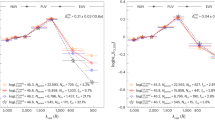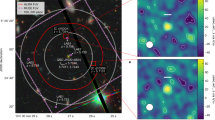Abstract
THE intrinsic extreme ultraviolet (EUV) spectrum of quasars, in which spectral lines of He and CNO ions should appear, is in most cases strongly absorbed by the hydrogen Lyman continuum of intergalactic matter at cosmological distances. The bright quasar HS1700 + 6416 (at redshift z = 2.72), from the Hamburg survey1, is a fortuitous exception, the line of sight towards it being relatively transparent. Here we report detailed ultraviolet spectroscopic measurements of HS1700 + 6416, obtained with the Hubble Space Telescope. We observe a rich absorption line spectrum, in which many EUV resonance lines (including He I, O II to O v, and N III and N IV) are seen. The O/C abundance ratios inferred from the line-strengths are higher than Solar System values by factors of 3 to 5. This suggests that the absorbing material is halo gas of early galaxies, from which population II stars have yet to form, oxygen being a primary nucleosynthesis product from a first generation of massive stars.
This is a preview of subscription content, access via your institution
Access options
Subscribe to this journal
Receive 51 print issues and online access
$199.00 per year
only $3.90 per issue
Buy this article
- Purchase on Springer Link
- Instant access to full article PDF
Prices may be subject to local taxes which are calculated during checkout
Similar content being viewed by others
References
Reimers, D. et al. Astr. Astrophys. 218, 71–77 (1989).
Møller, P. & Jakobsen, P. Astr. Astrophys. 228, 299–309 (1990).
Ford, H. C. Faint Object Spectrograph Handbook (Baltimore. Space Telescope Science Institute. 1985).
Tytler, D. Nature 298, 427–432 (1982).
Sargent, W. L. & Steidel, C. C. Astrophys. J. Suppl. 69, 703–761 (1989).
Lanzetta, K. M. Astrophys. J. 375, 1–14 (1991).
Chaffee, F. H., Foltz, C. B., Bechthold, J. & Weymann, R. O. Astrophys. J. 301, 116–123 (1986).
Steidel, C. C. Astrophys. J. Suppl. 74, 37–91 (1990).
Gehren, T. in Rev. mod. Astr. 1, 52–102 (1988).
Barbuy, B. Astr. Astrophys. 123, 1–6 (1983).
Bahcall, J. N. in Science with the Hubble Space Telescope (ESA-NASA Workshop, in the press).
Arnett, W. D. Astrophys. J. 219, 1008–1016 (1978).
Maeder, A. Astr. Astrophys. 92, 101–110 (1981).
Clegg, R. E. S., Lambert, D. L. & Tomkin, J. Astrophys. J. 250, 262–275 (1981).
Laird, J. B. Astrophys. J. 289, 556–569 (1985).
VandenBerg, D. A. in Production and Distribution of C, N, O Elements (eds Danziger, I. J., Matteucci, F. & Kjär, K.) 73–81 (ESO, 1985).
Gunn, J. E. & Peterson, B. A. Astrophys. J. 142, 1633–1636 (1965).
Tripp, T. M., Green, R. F. & Bechthold, J. Astrophys. J. 364, L29–L32 (1990).
Sciama, D. W. Astrophys. J. 364, 549–554 (1990).
Miralda-Escudé, J. & Ostriker, J. P. Astrophys. J. 392, 15–22 (1992).
Author information
Authors and Affiliations
Rights and permissions
About this article
Cite this article
Reimers, D., Vogel, S., Hagen, HJ. et al. The O/C abundance ratio in absorbing gas clouds at high redshift. Nature 360, 561–563 (1992). https://doi.org/10.1038/360561a0
Received:
Accepted:
Issue Date:
DOI: https://doi.org/10.1038/360561a0
This article is cited by
-
Fundamental Problems in Astrophysics
Astrophysics and Space Science (2006)
-
The Need for Ultraviolet to Understand the Chemical Evolution of the Universe and Cosmology.
Astrophysics and Space Science (2006)
Comments
By submitting a comment you agree to abide by our Terms and Community Guidelines. If you find something abusive or that does not comply with our terms or guidelines please flag it as inappropriate.



